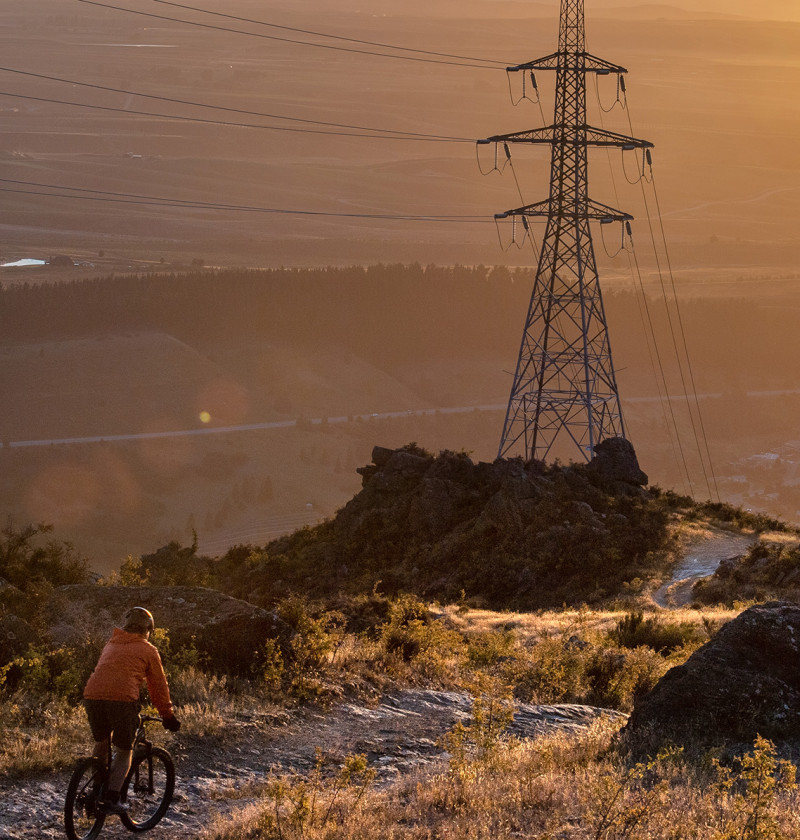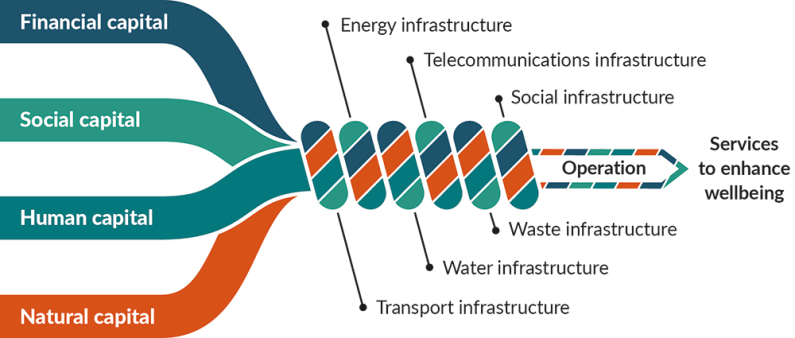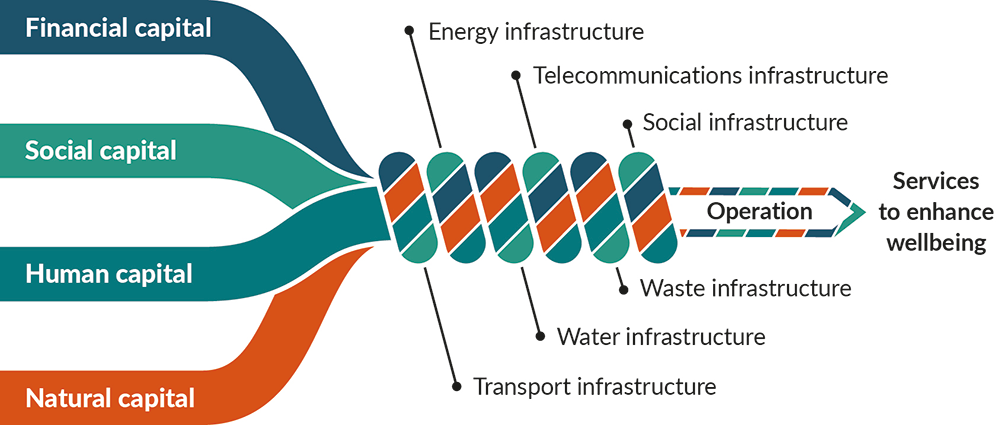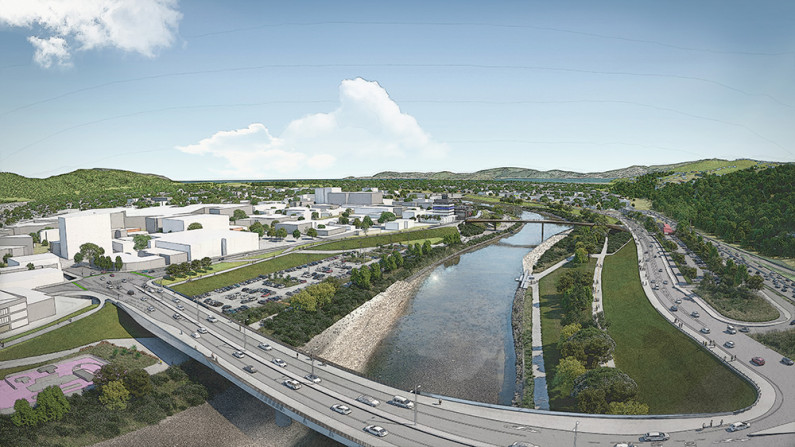Chapter 8 Infrastructure

The plan was published in 2022. Some actions in the plan were amended in January 2025 as part of the Government's response to the Climate Change Commission's national adaptation plan progress report. These updates reflect changes in circumstances since the plan was published, and align with the Government’s climate strategy.
See the response and updated table of actions for more details.
Infrastructure provides the services New Zealanders need for all areas of life. The actions in this chapter will help ensure these services remain resilient in the face of climate change. Resilient infrastructure supports adaptation in communities and businesses and protects the wellbeing of future generations.
B = Built
B1: Risk to potable water supplies (availability and quality) due to changes in rainfall, temperature, drought, extreme weather events and ongoing sea-level rise.
INF: Infrastructure
Infrastructure underpins our society. It provides the services we depend on to live, work, learn and play.
These services include:
For Māori, cultural infrastructure is important and is represented in social and cultural systems such as iwi, hapū and whānau. Associated physical and spiritual structures such as marae and urupā are also important.
Just as physical infrastructures of roads, telecommunication systems and energy systems must be resilient, so must cultural infrastructure for Māori.

Image: Data source – Adapted from Te Waihanga. 2020.*
Combining to form six types of infrastructure:
Ending with operation leading to services to enhance wellbeing.

Image: Data source – Adapted from Te Waihanga. 2020.*
Combining to form six types of infrastructure:
Ending with operation leading to services to enhance wellbeing.
Climate change will affect all of our infrastructure, directly and indirectly, including supply chain disruptions, physical impacts and changes in demand.
The actions for infrastructure in this plan are designed to achieve the three infrastructure objectives outlined in table 8 and address the built environment risks in the National Climate Change Risk Assessment 2020. In particular, they begin to address:
Resilient infrastructure protects and enhances the wellbeing of all New Zealanders.
|
Code |
Objective |
Explanation |
|---|---|---|
|
INF1 |
Reduce the vulnerability of assets exposed to climate change |
|
|
INF2 |
Ensure all new infrastructure is fit for a changing climate |
|
|
INF3 |
Use renewal programmes to improve adaptive capacity |
|
Infrastructure asset owners include central and local government and the private sector, onshore and offshore (table 9). This means there is a range of drivers underpinning the sectors’ collective response to climate change.
Important drivers for action in the private sector include board fiduciary duty, NZX rules, and investor sentiment on corporate responsibility and non-financial risk management. For Crown entities, government priorities and policy, as well as board fiduciary duty, will help direct responses. Local government decisions reflect long-term plans and will be influenced by the ability and willingness of ratepayers to pay.
Many asset owners have existing duties as lifeline utilities (table 9) under the Civil Defence Emergency Management Act 2002 to “function to the fullest possible extent, even though this may be at a reduced level, during and after an emergency” (s. 60 (a)).* Many asset owners may be beginning to consider climate-related risks as part of fulfilling their responsibilities as lifeline utilities.
* See the Civil Defence Emergency Management Act 2002 [New Zealand Legislation website]
|
Infrastructure type |
Governance |
Lifeline utility* |
|---|---|---|
|
Road transport |
Crown entity, central and local government |
Yes |
|
Rail transport |
Crown entity, central and local government |
Yes |
|
Ports |
Local government and central** government |
Yes |
|
Airports |
Private sector, central and local government |
Yes |
|
Energy*** |
Private sector |
Yes |
|
Water |
Local government |
Yes |
|
Telecommunications and digital |
Public and private sector |
Yes**** |
|
Waste and resource recovery |
Private sector, local government |
No |
* The Civil Defence Emergency Management Act 2002 identifies the entities and sectors that represent lifeline utilities, which include many of the infrastructure classes that this section seeks to influence.
** Defence land and infrastructure includes Defence Force camps, bases, training areas, airfields and ports.
*** Includes energy generation and energy distribution.
**** Radio New Zealand and Television New Zealand, and telecommunications network providers.

The RiverLink project will transform Lower Hutt through transport improvements, upgraded flood protection and urban development. The result will be a more resilient, connected and vibrant city.
The project is a partnership between Waka Kotahi NZ Transport Agency, Greater Wellington Regional Council, Hutt City Council and mana whenua Ngāti Toa Rangatira and Taranaki Whānui ki Te Upoko o Te Ika.
Improvements include:
Flood protection upgrades will include:
New spaces by the river include:
These works are also expected to lead to social and economic growth, and turn Lower Hutt into a true river-facing city.
All asset owners must begin the process of understanding and actively managing climate risk. Collectively, actions across this plan will support this process and help deliver on our objectives for the sector.
Chapter 7: Homes, buildings and places deals with many of the buildings and places defined as social and cultural infrastructure (figure 8), and that are included in other infrastructure types, eg, terminals and stations. Chapter 9: Communities contains adaptation of the health sector, including its built environment and the services it provides (social infrastructure).
Chapter 3: Enabling better risk-informed decisions, chapter 4: Driving climate-resilient development in the right locations and chapter 5: Adaptation options including managed retreat all include critical actions for infrastructure, as well as a number of supporting actions.
These include actions:
Additional critical and supporting actions for infrastructure are provided in this chapter. Table 10 illustrates how actions supporting the three infrastructure objectives are distributed throughout this plan.
|
Our infrastructure is resilient to a changing climate, so that it protects or enhances the wellbeing of all New Zealanders |
||||
|---|---|---|---|---|
|
INF1 |
INF2 |
INF3 |
||
|
Critical actions |
||||
|
Action 3.8: Develop guidance for assessing risk and impact on physical assets and the services they provide |
||||
|
Action 5.6: Scope a resilience standard or code for infrastructure |
||||
|
|
Action 4.6: Integrate adaptation into Treasury decisions on infrastructure |
|||
|
|
Action 8.1: Develop and implement the Waka Kotahi Climate Change Adaptation Plan |
|||
|
Actions that support infrastructure objectives |
||||
|
Action 8.2: Develop the National Energy Strategy |
|
|||
|
Action 8.3: Manage dry-year risk through the New Zealand Battery Project |
|
|||
|
Action 3.18: Review electricity and gas networks’ management of climate risk and resilience Action 5.11: Encourage and support the evaluation of climate risks to landfills and contaminated sites Action 5.12: Explore funding options to support the investigation and remediation of contaminated sites and landfills vulnerable to the effects of climate change Action 8.4: Provide for regulated network revenues to reflect the prudent and efficient costs of resilience |
Action 3.17: Support and promote the integration of climate adaptation and mitigation in new and revised standards commissioned by third parties Action 4.7: Integrate adaptation into Waka Kotahi decision-making Action 5.10: Develop and implement the Transpower Adaptation Plan Action 8.5: Progress the Rail Network Investment Programme Action 8.6: Invest in public transport and active transport Action 8.7: Embed nature-based solutions as part of the response to reducing transport emissions and improving climate adaptation and biodiversity outcomes |
|||
|
Action 8.8: Support knowledge sharing and the implementation of adaptation actions across the sector |
||||
|
System-wide actions relevant to infrastructure objectives |
||||
|
Action 3.1: Provide access to the latest climate projections data Action 3.5: Support high-quality implementation of climate-related disclosures and explore expansion Action 4.5: Reform institutional arrangements for water services Action 9.1: Modernise the emergency management system |
||||
|
|
Action 6.6: Implement the Water Availability and Security programme Action 10.1: Deliver the New Zealand Freight and Supply Chain strategy |
|
||
|
|
Action 4.1: Reform the resource management system |
|||
Understanding and managing risk at the asset level can result in a range of benefits, in addition to resilience – for example, making infrastructure services more reliable, providing better value for money and improving social cohesion.
Actions in this outcome area have the potential to reduce inequity and improve affordability of, and access to, infrastructure services – for example, investment in public and active transport, and consideration of future energy needs through the National Energy Strategy.
Development of system-level guidance, tools and methodologies, and adaptation plans, provides the opportunity to specifically consider the needs of all groups who may be disproportionally impacted by climate change, or who are least able to adapt. These include Māori, people of lower socio-economic status, disabled people, women, older people, youth and migrant communities. The guidance for assessing risk and impacts on physical assets and the services they provide will specifically include these considerations to encourage asset owners to undertake this analysis as part of their adaptation planning.
Consideration of disproportionate impacts of climate change on infrastructure services, and the implementation of actions to create resilience and build adaptive capacity, can also support giving effect to the principles of Te Tiriti o Waitangi. In addition, there is the potential for system-level guidance, tools and methodologies, and adaptation plans, to create space for mātauranga Māori to be integrated and expressed as part of adaptation planning.
Timeframe: Years 1–6 (2022–28)
Lead agency: Waka Kotahi
Relevant portfolio: Transport
Primarily supports: Objective INF3
Status: Current
In 2022, Waka Kotahi will publish and begin applying an adaptation plan. This will outline how Waka Kotahi will adapt to climate change through the design, delivery, operation and use of the land transport system.
The plan will address exposed existing assets and new investment in infrastructure. It will also explore adaptation in maintenance programmes of the roading network, including renewals.
Waka Kotahi will consider multiple risks to the land transport system from climate hazards, including sea-level rise, flooding and landslides. It will lead, collaborate on and support land transport adaptation to enable climate-resilient transport networks and journeys, connecting people, products and services for a thriving Aotearoa.
By 2024, a reporting framework on the implementation of the adaptation plan will be developed.
Timeframe: Years 1–3 (2022–24)
Lead agency: MBIE
Relevant portfolio: Energy and Resources
Primarily supports: Objective INF2
Status: Current
The Government has committed to developing an energy strategy by the end of 2024, fully collaborating and engaging with Māori and working with energy system stakeholders. The vision is for a net-zero economy in 2050, where energy is accessible and affordable, secure and reliable, and supports New Zealanders’ wellbeing. The strategy addresses challenges in the energy sector and signals pathways away from fossil fuels.
Timeframe: Years 1–6 (2022–28)
Lead agency: MBIE
Relevant portfolio: Energy and Resources
Primarily supports: Objective INF1
Status: Current
The New Zealand Battery Project will assess the options for managing dry-year risk in a highly renewable electricity system. The current focus is on the feasibility of pumped hydroelectricity at Lake Onslow. The feasibility study will be completed by the end of 2022. The aim is to increase the resilience of the electricity system when hydro lakes have low inflows for long periods.
Timeframe: Years 1–6 (2022–28)
Lead agency: Commerce Commission
Relevant portfolio: Commerce and Consumer Affairs
Primarily supports: Objective INF1
Status: Current
In the Commerce Commission’s next reviews of regulated price-quality paths – from 2025 for electricity networks and from 2026 for gas networks – it will consider the extent to which revenue limits should provide for different expenditure levels from the current period. This will include if expenditure levels need to change due to any increased costs of resilience to climate change, where these are based on robust forecasts. Regulated suppliers can also apply for changes to their revenue limits to better meet their particular circumstances, which could potentially include the prudent and efficient costs of resilience initiatives.
Timeframe: Years 1–6 (2022–28)
Lead agencies: MOT; Waka Kotahi
Relevant portfolio: Transport
Primarily supports: Objective INF2
Status: Current
KiwiRail’s Rail Network Investment Programme (RNIP) is a 10-year programme of investment in Aotearoa New Zealand’s rail network, to restore it to a resilient and reliable state. Mitigating climate change is a key focus within the RNIP when considering resilience projects for investment. Restoration of the national rail network to a reliable and resilient state will also reduce its vulnerability to climate hazards and provide a platform for future investment to support growth. In addition, mode neutrality (using a range of transport modes) supports resilience within the national supply chain.
Timeframe: Years 1–6 (2022–28)
Lead agency: MOT; Waka Kotahi
Relevant portfolio: Transport
Primarily supports: Objective INF3
Status: Current
Investment in multi-modal infrastructure can increase the resilience of the transport system and help manage the vulnerability of existing assets. More use of public transport and active modes will help reduce reliance on private vehicles. It will increase system redundancy, improve equity and support sustainable growth. Safe and attractive alternatives to driving create a more resilient transport system, support sustainable growth and reduce emissions.
Timeframe: Years 1–3 (2022–25)
Lead agency: MOT
Relevant portfolio: Transport
Primarily supports: Objective INF2
Status: Current
Nature-based solutions involve sustainable management and natural features and processes to tackle socio-environmental challenges such as climate change. At a local, regional and national scale these measures can reduce transport emissions and improve climate adaptation as well as biodiversity. Key initiatives include:
Timeframe: Years 1–6 (2022–28)
Lead agency: Te Waihanga
Relevant portfolio: Infrastructure
Primarily supports: Objective INF1
Status: Current
Te Waihanga will convene a regular event for local government, central government and private sector asset owners to share information on the implementation of actions in the national adaptation plan and to support alignment across the sector.
Initially, the focus may be on the scope and content of the actions on adaptation guidance that Te Waihanga has committed to in the national adaptation plan, but may also provide a forum for updates on other policy matters relevant to infrastructure asset owners.
Many government work programmes will help build the resilience and adaptive capacity of new and existing infrastructure assets, and include the following actions.

Chapter 8 Infrastructure
August 2022
© Ministry for the Environment